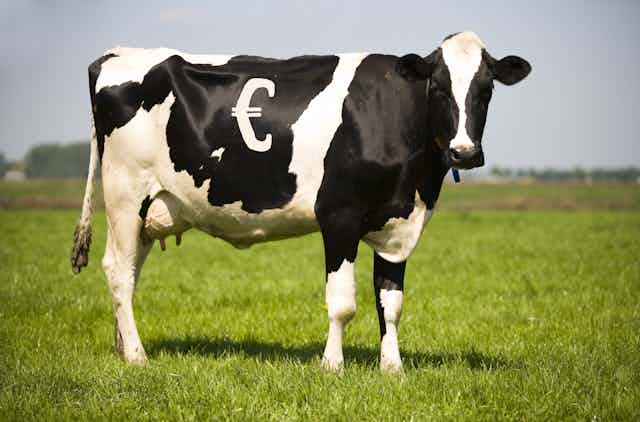You’ve probably heard the stories of huge butter mountains and wine lakes, and moneybags landowners living the high life thanks to subsidies from unwitting urbanites. But there’s more to the EU’s Common Agricultural Policy than these cliches. With the farm subsidies already a major issue in the UK’s referendum on EU membership, let’s look at what this really involves.
It’s not hard to see how the Common Agricultural Policy became known for pointless excess. When it was created in 1962, the CAP supported farmers primarily through ensuring artificially high prices for their products. This was achieved via “price support”, which turned member states into an economic island, with prices higher than elsewhere. As a direct result, farmers were encouraged to produce more and more.
Since this would drive down prices, a system of “intervention buying” was introduced. If farmers couldn’t sell their stuff at a high enough price, they could sell to the government instead. But this gave farmers a guaranteed buyer, so they knew they could produce and sell as much as possible. This led, in the 1980s, to huge stored surpluses of commodities including infamous amounts of butter and wine (actually industrial alcohol – there were never vats of Cabernet or Chardonnay lying around).

Since then, more than 20 years of CAP reforms have led to the removal of these high prices and, with it, the ending of such surpluses.
The cost of common agriculture
We’re dealing with very large numbers here and some perspective is necessary. Agricultural policy is a big deal in terms of EU spending – only development aid for poorer regions can compare – but perhaps less so when compared to the UK’s national budget.
In 2014, the EU budget as a whole was just under 1% of the union’s “gross national income”, whereas the UK budget that year was about 44% of its gross domestic product (GDP). These are two slightly different ways of measuring national wealth – but not that different.
The UK government expected to spend £743 billion last financial year, approximately €960 billion at current exchange rates. The EU plans to spend €155 billion this year, with about €62 billion, or 40%, earmarked for agriculture and rural development. This is equivalent to just over 6% of total UK spending. For the entire EU.
What the UK gets
The UK paid €14 billion (£11.3 billion) into the 2014 EU budget, and received back €7 billion (£5.6 billion) in payments, mostly agriculture subsidies and regional development support. Payments into the EU budget are based on national income whereas the amount a country receives in EU farm subsidies is largely dictated by the size of its agricultural sector. This means a richer, urbanised, nation like the UK, where farming is relatively small, and which is a net food importer, will tend to be a large net contributor to the EU budget.
In the 1980s, when the UK was comparatively poorer, it started to receive a partial rebate on its net payment. Even now, although the country has become much richer, it still receives a rebate. In 2014 this was worth just over €6 billion (£4.9 bn), leaving the UK’s net contribution to agricultural policies in other countries at approximately €1.27 billion, or about £16 each.

UK farmers received €3.2 billion in direct farm subsidies in 2014. More than half of this cash went to farmers who each received less than €50,000, though about 13% went to farmers who were granted more than €150,000, and 2% of the total went to the largest farms and landowners who raked in €500,000 or more that year.
That last group tends to make the headlines, but it’s worth bearing in mind that these megafarmers and landowners such as the National Trust represent just 0.04% of the UK’s CAP funding recipients.
The Brexit case
One argument made by Brexit advocates is that payments to the EU could then be spent on other things. Yet the numbers above show how little money the UK would actually gain from this. The country also wouldn’t suddenly stop spending money on agriculture and the rural economy.
On the one hand, Theresa Villiers, a cabinet member and a Brexit supporter, recently suggested that the UK could spend even more money on agriculture if it left the EU, limiting the money available for other policies.
On the other, as a previous decision not to fund rural development shows, the Treasury is not well disposed to these areas of spending. The rural economy could lose out. Significantly. This indicates the uncertainty surrounding an EU exit and the nature of the financial battles within the UK that would ensue.
The UK is part of the EU’s international trade obligations under the World Trade Organisation (WTO). After Brexit, it would have to negotiate a new set of obligations with the WTO, including negotiating with the EU over a share of the trade permissions already granted.
This is no simple task, and the EU would have little incentive to be generous in those negotiations. In addition, if any agreement between the UK and EU disadvantaged other countries’ agricultural trade interests, they could bring an action in the WTO, including against the UK, for compensation.

